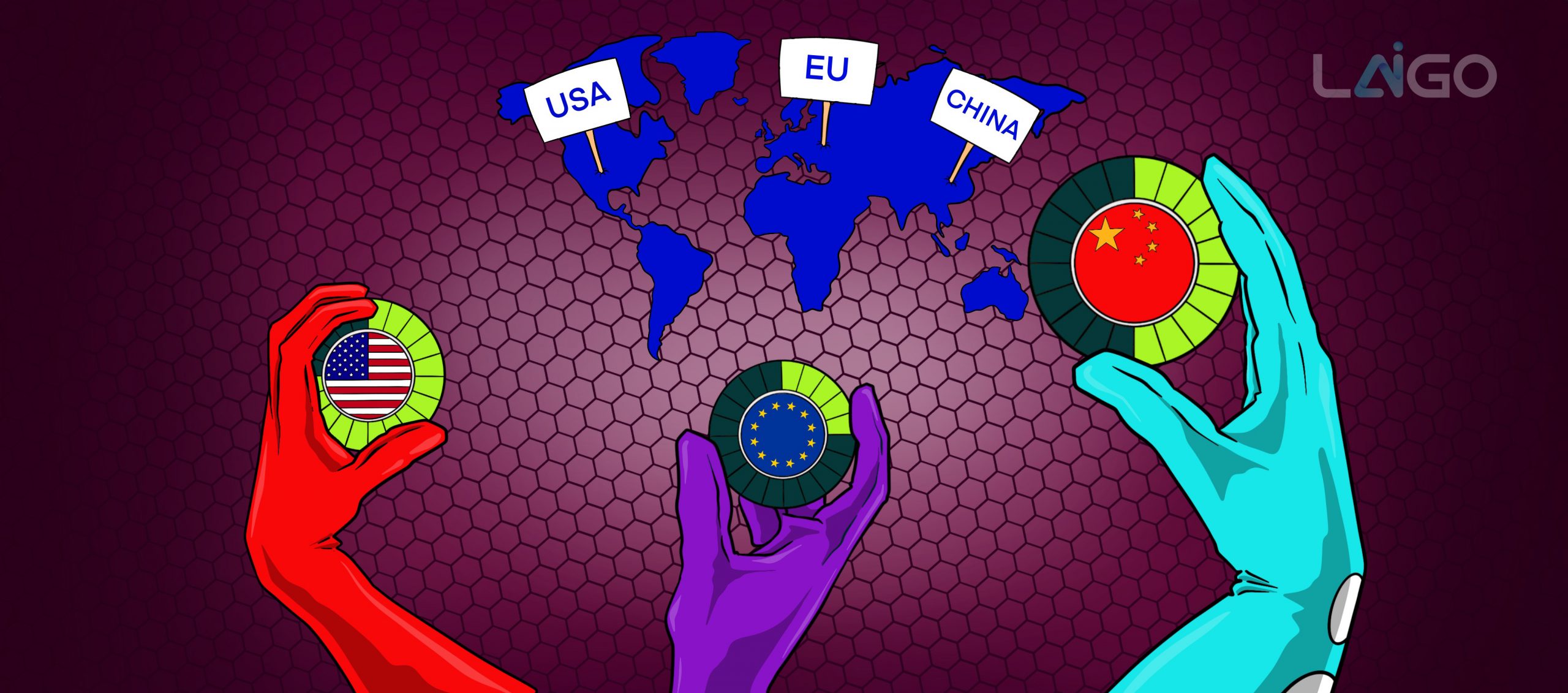In one of the previous blog posts, we mentioned that according to the Bitkom survey on the status of AI in companies from the summer of 2022, Germany has fallen behind the USA, China and Japan in the view of the respondents and is unlikely to catch up in the coming years. Respondents see the U.S. in first place currently and China in second place in the coming years, with a reduced gap to the U.S. for 2030. What makes the USA and China so successful in terms of AI?
USA
Technological innovative strength and established cooperation structures between authorities, companies and research institutions are the basis for the U.S.’s leading position in AI development, according to the Denkfabrik des Bundesministeriums für Arbeit und Soziales. Since 2016, the U.S. has had an AI strategy with seven priorities for AI development, with an eighth added in 2021. These include aspects such as “long-term and strategically prioritized investments in AI research,” but also consideration of “ethical, legal, and societal implications of AI.” With the “development and public provision of high-quality data for training and testing artificial intelligence” and the “needs assessment and promotion of R&D personnel in the field of artificial intelligence,” the strategy contains two factors whose absence the respondents to the Bitkom study lament as major obstacles to AI use.
In the USA itself, the situation is assessed less optimistically than by the respondents to the Bitkom study. The National Security Commission on Artificial Intelligence, sees China in the fast lane and calls for increased financial efforts for non-military and for military research and development in AI to keep the U.S. at the forefront. It calls for $32 billion per year for non-military AI R&D alone. So money certainly doesn’t hurt when it comes to unlocking and harnessing
According to its AI strategy presented in 2017, China wants to displace the USA from the top position with investments of 150 billion dollars by 2030. According to the Denkfabrik des Bundesministeriums für Arbeit und Soziales, cornerstones of the strategy are initiatives for research and development, talent development and specialist education measures, as well as security. In particular, the focus is to be on developing smart products such as connected vehicles, intelligent service robots and video image recognition systems, smart manufacturing and support systems, and infrastructure development. It also aims to expand collaboration between universities and private tech companies. Skill development, application of AI technologies, and testing of new strategies to promote and deploy AI applications are being advanced in national AI development zones.
EU / Europa
In the EU, or rather in Europe, other states such as France or the United Kingdom are strong in artificial intelligence in addition to Germany. Since a single state in Europe can do little financially against the really big economies, the European Commission has developed four key areas for more efficient cooperation between the Commission and the EU states, Norway and Switzerland as part of its AI strategy in 2018. With the help of better coordination of investments and the generation of synergies, Europe should “seize the opportunities of AI for the benefit of its citizens and businesses” and remain “globally competitive.” Key areas include “increasing investment,” “making more data available,” “fostering talent” and “building trust,” particularly in areas of public interest such as “healthcare, transport and mobility, and security and energy.” Countries are asked to develop and fund national strategies within this framework.
In terms of investment, more than 20 billion euros a year in public and private money is to flow into research and innovation in the field of AI by 2030. At least 7 billion euros per year are to come from various EU programs for this purpose.
AI-Regulation
Another factor affecting development in the field is regulation. Not only the EU, whose planned AI regulation we presented in one of the previous blog posts, but also other countries see a need for action with regard to ethical, legal and social aspects of AI use. Already in 2019, OECD member countries along with partner countries have agreed on initial principles for dealing with artificial intelligence. They are intended to ensure that AI systems operate in a stable, secure, fair and trustworthy manner.
In the U.S., this thematic complex, see above, is part of the U.S. AI strategy. Regulations are emerging, such as the AI Bill of Rights, a kind of – albeit non-binding – fundamental rights charter with guidelines for AI development. It aims to protect citizens from algorithms that make automated decisions. It focuses on rules such as protection against unsafe or ineffective systems and against algorithmic discrimination, self-determined handling of data and transparent information on the use of automated systems, as well as options for using a human alternative instead of automated systems.
China also has a code of ethics with basic requirements such as promoting fairness, equity, and safety, avoiding discrimination and data misuse, and ensuring AI is controllable and trustworthy. However, there is a not insignificant difference with the planned AI regulation in the EU: in the EU, the AI regulation is to apply to anyone who manufactures, markets or uses AI solutions, government agencies included. In China, the code does not apply to government agencies; they can also use AI solutions that are likely to be prohibited under the planned EU AI Act.
Conclusion
China is seen as having a good chance of becoming the leader in the field of AI, as it has everything it needs besides money: vast amounts of high-quality data, tenacious and high-class entrepreneurs, well-trained AI engineers, and a supportive political environment. But the U.S. is not in a bad position either and could also defend its position in the long term. From a European or EU perspective, it should be clear that the top positions have been awarded uncatchably. Nevertheless, the EU and Europe are likely to remain at the forefront, especially in terms of AI use across the board. For the time being, it remains to be seen what effect existing codes and regulatory proposals will have in the future, also in conjunction with data protection regulations.



